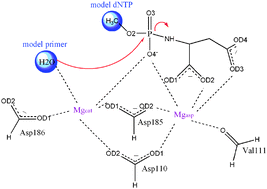Hydrolysis of aspartic acid phosphoramidate nucleotides: a comparative quantum chemical study
Abstract

* Corresponding authors
a
Katholieke Universiteit Leuven, Department of Chemistry and LMCC-Mathematical Modeling and Computational Science Center, Leuven, Belgium
E-mail:
servaas.michielssens@chem.kuleuven.be
b Katholieke Universiteit Leuven, INPAC Institute of Nanoscale Physics & Chemistry, Leuven, Belgium
c Katholieke Universiteit Leuven, Rega Institute for Medicinal Research, Medicinal Chemistry Laboratory, Leuven, Belgium

 Please wait while we load your content...
Something went wrong. Try again?
Please wait while we load your content...
Something went wrong. Try again?
S. Michielssens, N. Tien Trung, M. Froeyen, P. Herdewijn, M. Tho Nguyen and A. Ceulemans, Phys. Chem. Chem. Phys., 2009, 11, 7274 DOI: 10.1039/B906020K
To request permission to reproduce material from this article, please go to the Copyright Clearance Center request page.
If you are an author contributing to an RSC publication, you do not need to request permission provided correct acknowledgement is given.
If you are the author of this article, you do not need to request permission to reproduce figures and diagrams provided correct acknowledgement is given. If you want to reproduce the whole article in a third-party publication (excluding your thesis/dissertation for which permission is not required) please go to the Copyright Clearance Center request page.
Read more about how to correctly acknowledge RSC content.
 Fetching data from CrossRef.
Fetching data from CrossRef.
This may take some time to load.
Loading related content
